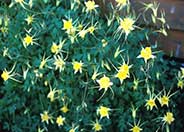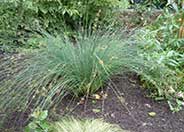
Common name:Forest Pansy Redbud
Botanical name:Cercis canadensis 'Forest Pansy'
This small tree may reach 25' tall and it has dark green/purple leaves that are purple in the fall. Amazing pink flowers bloom in the spring and fill the tree.

Common name:Columbine
Botanical name:Aquilegia hybrids
Coumbine has large, spurred flowers with clear colors of white, lavender, yellow, deep red and pink which are borne on 2 1/2' tall plants. The strikingly beautiful blooms make good cut flowers. They require partial shade or full sun, along with well- drained soil. The colors, however, cannot be chosen.

Common name:Howard McMinn Manzanita
Botanical name:Arctostaphylos densiflora 'Howard McMinn
This shrub is highly appreciated for its decorative characteristics, which include a dense show of small, pale pink urn-shaped flowers. Above all, it is the mahogany-red to brown bark (which peels beautifully) that is the major attraction. Its fruit resembles the tike apple, and the flowers contrast perfectly to the light green leaf (which can get rather tough). It blooms from late winter to spring.

Common name:California Wild Grape
Botanical name:Vitis californica
The California Wild Grape is a woody deciduous vine that with round large leaves. The flowers are in small fragrant blooms and berry clusters appear in the summer. This vine has a sprawling, climbing growth habit. The California wild Grape is native to California and is drought tolerant.

Common name:California Gray Rush
Botanical name:Juncus patens
Although a wetland plant, Juncus patens can tolerate fairly dry conditions. It will slowly clump to 2'-3' wide and a height of 2'-2.5'. There are many selections of this species available with different heights and widths. It is carefree, with little to no maintenance. It provides great upright structure to many styles of landscapes.
Dealing With Drought
More than half of the water used at your home is for outside purposes. Studies show that on average, half of the water used outdoors is wasted. The leading cause of waste is incorrectly set and poorly managed irrigation controllers. The second biggest cause of wastage is broken irrigation equipment that goes undetected. There are a few basic things you can do to make a big difference in your water use.
Click in the green box for more information
| Designer: Owen Dell | View Nature from the Patio |
Photographer: GardenSoft |
Soils and Compost:
Maintain a two to four inch layer of mulch on the soil surface to reduce weeds, infiltrate rain water, and reduce compaction.
Water Saving Tip:
Integrated Pest Management:
Remove irrigation water and fertilizer from areas where you don't want weeds to grow.

